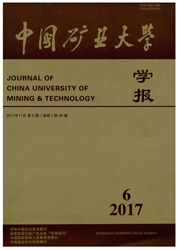

 中文摘要:
中文摘要:
在现场实测和实验室物理模拟基础上确定了10个影响软弱夹层顶板巷道安全性的因素.通过层次分析法对各因素进行权重评判,结果表明软弱夹层层位、受水影响程度等是影响该类巷道稳定性的主要因素.借助物元可拓性定性方法和可拓关联函数定量方法,提出了一种新的含软弱夹层顶板巷道安全评价模型,对实际生产矿井该类巷道的评价指标进行数据预处理,得到反映软弱夹层顶板巷道安全状况的5种等级,即非常危险、危险、相对安全、较安全、安全,并为控制对策提供理论依据.利用该模型对芦岭矿1184回风上山安全稳定状况进行可拓评价,计算结果表明该巷道等级为较安全,与现场实际较吻合,验证了该模型的可靠性与准确性.
 英文摘要:
英文摘要:
Ten factors influencing the safety of identified. In situ measurements and laboratory roadway roofs with weak intercalated layers are physical models were used during the idenfification. The analytical hierarchy process (AHP) method was used to weight the factors. This showed that the location of the soft interlayer and the impact of water were the main factors af- fecting roadway stability. A new safety assessment model for roadway roofs with weak intercalated layers is proposed. Qualitative and quantitative analyses using extensible elements and extension dependence functions were used with the model. This provided the theoretical basis for control methods. The methods are applied to roadways than can be divided into five grades: extremely dangerous, dangerous, intermediately safe, relatively safe, and safe. Pre-processing of data from the field is used to classify production mines in these various conditions. This model is ap- plied in the safe-assessment of the II84 air-return roadway in the Luling coal mine. The results show that this roadway is relatively safe, which was consistent with the in situ measurements.
 同期刊论文项目
同期刊论文项目
 同项目期刊论文
同项目期刊论文
 期刊信息
期刊信息
